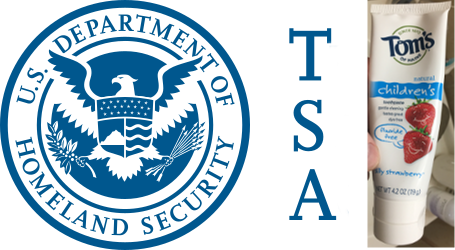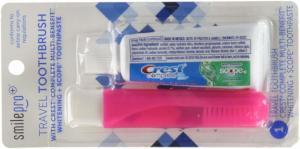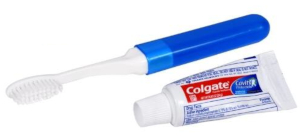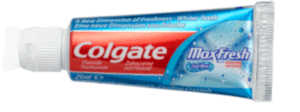Toothpaste on a Plane
Yes: 3.4oz/100 ml in a carry on. More can be checked in if you want to bring more toothpaste on a plane.

Can you bring toothpaste on a plane? In your carry on?
Yes: 3.4oz/100 ml in a carry on. More can be checked in.
Given that the size of your toothpaste and its container, be it in a bag, pouch, resealable Ziploc, purse or other similar item, is in proper compliance with all local and federal guidelines, this should be no problem. These rules vary from country to country. The most esteemed and recognized law enforcement division, in this respect, not to mention the largest in the world, is that of the Transportation Security Administration --- more commonly referred to as the TSA. It is an entity of the U.S. government and dominants guidelines and even sanctions behind international travel, detailing even the most minute circumstances and permissions, including those of which toothpastes and toothpaste containers are allowed on each flight.

Generally, toothpaste of any size is permitted in a checked bag. For carried bags, it must be 3.4 oz. or smaller. The rules are the rules.
Can you use toothpaste on a plane?
Probably yes, but brush in the bathroom. Remember this as a rule of thumb, a word to the wise: If you are carrying your carry-on luggage with you on the plane, and your toothpaste has successfully passed the grip of the stringent TSA’s grasp --- whether by unexpected mere luck or by properly passing all guidelines in tested compliance --- you are now free to brush those teeth while on the plane. But just remember that turbulence can happen at any moment, so for some, it may be wiser to wait. But if you simply cannot wait, then brush away, and make sure to keep one hand on the lavatory handrail at all times, if possible.
The problem with brushing on the plane, but not in the lavatory, is simple: If turbulence occurs, your new pack of toothpaste could go flying out of your hands and down the aisle, perhaps never to be seen again. It could spill on your new shirt or all over your face. It could wake up the now-very-angry fellow passenger in front of you, on whom its tube contents spilled. Do consider the consequences and, to be safe, use at your own discretion, under your own supervision, within the locked plane lavatory --- dispose any used containers there as well while you’re at it.

What size does the tube need to be?
As briefly mentioned, if the tube of toothpaste is of 100 ml or less in size --- in other words, 3.4 ounces (100 ml) or less --- then it is permissible as a checked item within your checked or unchecked carry-on bag. For more on that note, and as it applies to U.S. passengers and flights, please see the official TSA guideline HERE. And do remember that any employee of the TSA may confiscate any item or its container or bag, even one that is in full compliance to all posted or stated signs and regulations, at any time and for any reason --- the final decision will always remain with the regulation employee in charge.
To find the size of the toothpaste tube, simply see the label on the back or look up the product by name online before bringing it to the airport. This way, you can ensure yourself that you have done your research and will pass your item through the screening points with flying colors. Ah, it sure is good to be “in compliance”, is it not?

Is toothpaste considered a liquid on a plane?
Yes, the TSA does consider toothpaste to be a liquid. You will need to follow the normal rules for liquids when packing toothpaste. You can only bring a small amount in your carry on.
Is toothpaste allowed in checked luggage?
Yes, you can pack more toothpaste if you put it in your checked luggage. Checked luggage is allowed to have larger containers of liquids packed than carry on bags.
If you want to bring a large tube of toothpaste, put it in your checked luggage.
What happens if it is too big?
Security may take it, so let’s talk about how terrible this is for some. First, it can cause a public embarrassment, which is never fun for those on the receiving end --- in this case, you and the party you are traveling with. And if security confiscates your item, it only makes the screening point slower and takes up more precious time, not only for you and those that you are traveling with ---- but also for the TSA employees and for the passengers in line behind you. Think of it like this: When you pass through any security screening point, your goal should be to get in and get out as quickly and efficiently as possible, having the least amount of things that can draw the ever-watchful eye of the TSA in your unfavorable direction. Let’s agree on that.
Also, a confiscated item means you will either need to continue without keeping the item, or you must go through screening again but must pass. The choice is yours. In some cases, the enforcers may toss out the item entirely, dependent upon the circumstances and other factors. A lost item means wasted money and one less resource you will have with you, so ask yourself if it is worth it.
Is this rule different if you are not traveling to or from the USA? (ex: England to China?)
Some international airports use what they call “oversized fees”, which allows them to pass the item through as a carry-on on the plane, in the event that it occupies a seat. Some items are so large that they occupy a seat and cannot fit in the overhead cabins --- in this case, though they may be permitted, the owner must still pay for an extra plane ticket to place the item in the seat. Many non-international airports employ this guideline as well, though some airlines may be more stringent in its use than others. It all depends on the carrier, too.
These airports allow this because they understand the need of the passenger in legally transporting one personal, prized possession from a country to another. They also take advantage of the opportunity, as many postulate, and may thus charge some hefty fees for allowing such privileges. Those traveling from France to Africa, as an example, may purchase an extra plane ticket in order to place one item (one oversized item per seat purchased) on a seat as if it were a passenger --- but can expect to pay to do so. It’s called a service, after all, a price-inducing privilege and a right.
Finally
Let the facts speak. That’s toothpaste on a plane, folks. Those are the rules.
